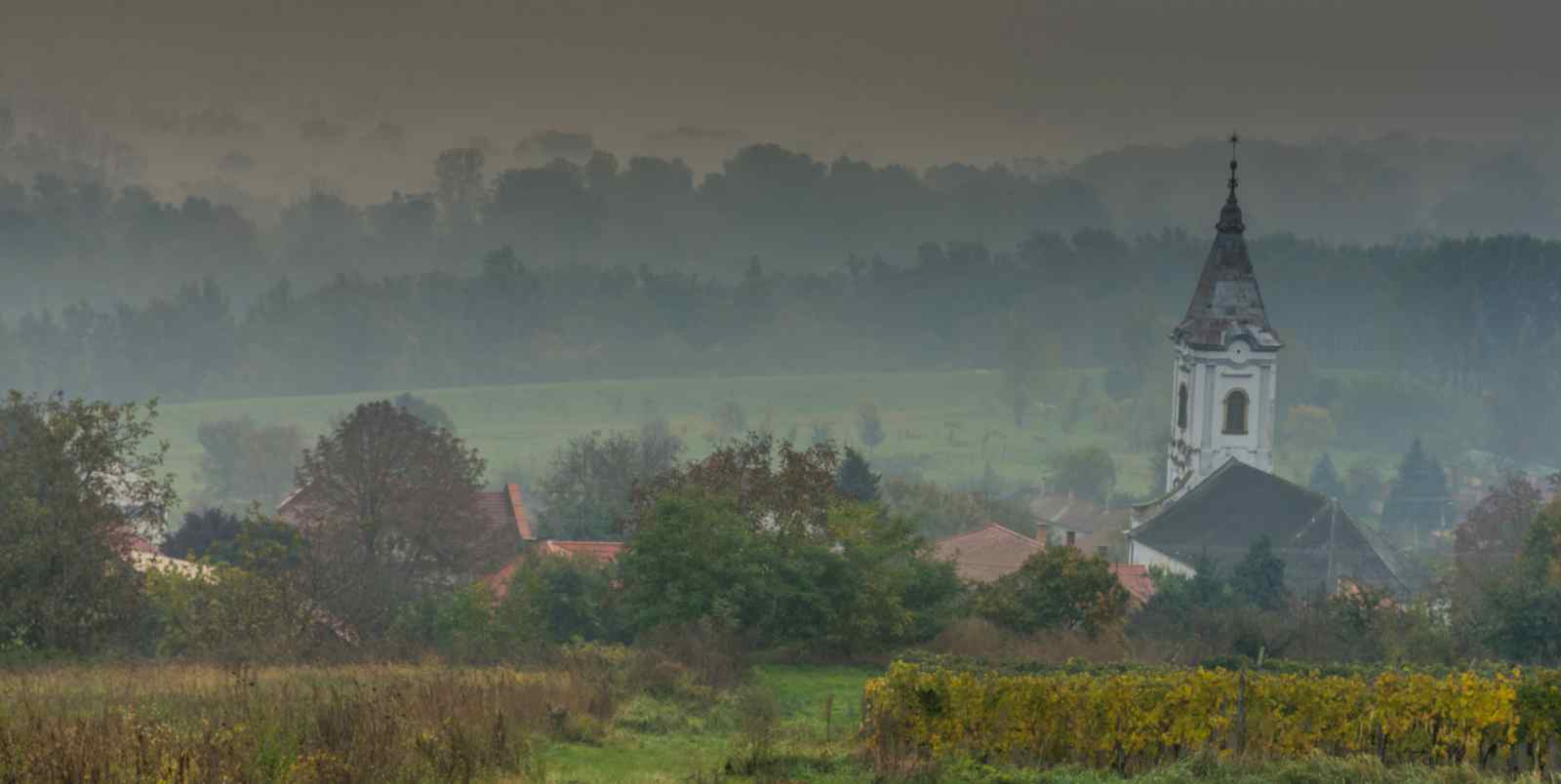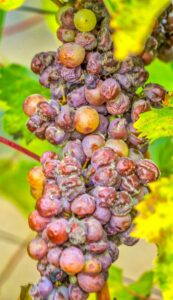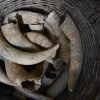Szamorodni was arguably the first wine type of Tokaj which has been regarded as the superior style. The story goes back to the year of 1570 when the first written mentioning occurred; the people made clear distinction between the so-called “ordinari” or generic wine and the “főbor”. This could be translated into main-, chief-, head-wine but also as “leading-wine”. The main difference was in the raw material, the főbor had a high percentage of shrivelled, botrytized (noble rot), aszú berries in the clusters and they processed it together in the cellar with the healthy berries. Hence no selection berry of berry per sé took place other than necessary -later ripened- bunches were selected.
How did the word szamorodni develop?
Poland was a great advocate of fine Tokaji, they appreciated the wines of the region as well as had a vivid trade system in place. They most likely started to use their own expression for this type of wine, as it´s born or in Polish; samorodno vino as Miles Lambert-Gócs recalls in his book, Tokaji Wine. I remember on my first visit to Poland at the Enoexpo Wine Show in Krakow I had the pleasure of speaking in front of a 50+ enthusiastic crowd of wine professionals, giving a master class on Hungarian wine. I insisted on a sweet Szamorodni to be placed into the line up yet I was nervous whether szamorodni is really something the Polish people still remember, since they basically re-invented it and were so fond of. And indeed they did know all about Tokaj and szamorodni, there was definitely an energy in the room, something which you may experience when a “good old friend” enters the place, you haven´t seen for ages.
Photo credit: Attila Somogyi
Back in 2019 at the Vince Magazine I commented after the blind tasting that szamorodni (szamo if you like the shorter version do use it…) is a very valuable wine combining history, personality and a lot of potential. The sweet szamorodni should all about fine, ripe, bold fruit with the distinct presence of botrytis and freshness, acidity in combination with depth, medium full body, a delicate grip and oily texture with a richness of ripe fruit, sweet spice, layers of complexity. Side comment dry szamorodni is a different style and may be discussed in a different post.
There was a tendency to produce sweet szamorodni with low sugar levels (around the 60-70 g/l range) and even longer ageing times yet I have the feeling this becomes less favourable by many producer, especially the top tier.
The product specification of Tokaj states that for a sweet szamorodni the aszú, botrytized berries must be picked together with the healthy berries and processed together in the cellar as well. Minimum of 6 months barrel ageing is required and the wines can only be released earliest after the second year of the vintage and must be at least 45 g/l of residual sugar.
“Micro-climate” is crucial in the development of botrytis
Szamorodni due to the technology and philosophy is always richer than a generic late harvest wine. And if someone is looking at the shrivelled berry content a sweet szamorodni has more botrytis than an aszú wine. Why? With an aszú wine the producer on one side will have the pure “aszú”, hence fully botrytized grapes and this will be soaked for a day or so in either: must, or fermenting must or base wine. The style of the aszú much depends on the winery as well as on the ratio used, but nevertheless szamorodni will have more pure botrytis content compared to the aszú wines.
While there is a range of styles when it comes to sweet szamorodni especially due to the various sweetness levels, richness of the final product yet the future should be about consistency as aszú -the top sweet wines- may not be produced every year. But szamorodni does show the complexity and beauty as well as personality and history of the Tokaji wine region.
While Aszú wines are certainly the top of the chain often enjoyed by themselves, szamorodni is a rather versatile drink, great match to a number of food and occasions as well.
So I encourage you to chill a bottle or two down to 11-13°C and you can drink the szamo up-on release, even 3-4+ days opened in the fridge will not affect it negatively and have it with any food you like. Try the sweet, sour and spicy flavour profiles…
See below some of my recent tastings and most memorable sweet szamorodni wines. All of them are sweet szamorodnis. There is no particular order other than increase in vintage date, short comment also given on the vintage.
Vintage 2013: fantastic year for botrytis, plenty and of great quality.
Barta, Öregkirály Dűlő Szamorodni 2013
Lovely honey, stony mineral, pronounced fruit driven nose. Full of quince pear, Williams pear, dried fruit of apricot and honey in the back. Sweet with 115 g/l of purity backed up by high acidity, velvet texture, waxy note followed by even some floral mood, ylang ylang, ripe pear, lemon crust, marmalade. Vivid, well made.
Drink now – 2035
Vintage 2014: Early ripening with rain and colder temperatures, rather a challenging and short vintage. Lower quantity yet good with concentrated quality.
Pajzos, Szamorodni 2014
Deep gold with ripe quince and refreshing spice on the nose, full of peach and lovely perfume. Full bodied with 12,5% abv. fairly vinous style with a creamy texture, silky, smooth, powerful fruit driven, Williams pear, tangerine, sweet spice of cinnamon, ginger, complex and long.
Drink now – 2028
Vintage 2016: cooler year with plenty of rainfall. Yet if managed properly some awesome freshness may be achieved beside the moderate yet good botrytis
Szepsy, Szamorodni 2016
Gold colour with lovely spice, ripe fruit full of botrytis, quince apple, apricot, allspice, nutmeg, tropical fruit, maracuja, honey. Lovely sweetness with 12% abv, vivid and pure with plenty of fruit, apricot, quince and sweet spiciness, long lingering even some firestone minerality in the back. Pure and dense with an awesome length. Especially good considering the difficult vintage for classic sweet wine.
Drink now – 2040
Vintage 2017: ups-and downs during the vintage yet the year could produce some incredibly fine botrytis, great quality and quantity, a year to look forward; somewhat similar to 2013 but perhaps with more freshness.
Juliet Victor, Szamorodni 2017
Gold colour, expressive nose full of honey, lime blossom, tropical fruit of maracuja, dried apricot and prune. Very luscious on the palate, certainly a “super-charged” style of szamo, orange, raisin, tropical notes and exotic spice with almost 190 g/l of sweetness certainly no lightweight yet the freshness is keeping up.
Drink now – 2030
Disznókő, Szamorodni 2017
Seductive, sweet spice on the nose with a fair intensity showing dried fruit and quince, peach as well as a hint of floral tone. Quite full bodied with a rich mouth-feel, layered, fine but firm grip yet vivid, playful and plenty of sweet fruit, honey and lovely spiciness in the back. Luscious and concentrated sweetness with great balance of freshness, scratching the 150 g/l sugar mark and 12,5%abv. Well made! The 2018 has just come out, looking forward to try a bottle in the near future…
Drink now – 2035
Péter Pince, Szamorodni 2017
Medium deep lemon colour. Plenty of candied fruit, honey, quince, tangerine and even a hint of bergamot underlined by delicate, fresh vanilla. Concentrated sweetness, full bodied with a clean and straight forward style, dried apricot, nutty, tropical combination with luscious sweetness, 140 g/l pure sweetness backed up with freshness. Some may even say full bodied yet refreshing as well.
Drink now – 2030
Gizella Pince, Szamorodni 2017
Gold colour. Intense nose, clean and bright full of botrytis, apricot, quince, mint leaf, sweet spice. Multi-layered , with spice, mint, sweet botrytis driven nose, typical yet multi-layered rich and complex, dash of salty minerality in the back, full of energy. With a long finish and plenty of ripe fruit and freshness. Well made, clean and bright with finesse.
Drink now – 2035
Balassa, Bomboly Szamorodni 2017
István makes a number of szamo´s, single vineyard based ones, seven if I recall correctly. Nyulászó is delicious but bit dense for my taste; my favourite is the Bomboly, graceful and sublime harmony between freshness and awesome sweetness. Gold colour. Full of sweet fruit, floral, fine spicy. Ripe pear, quince, dried apricot, fig with a gentle honey tone. Rich and bold on the palate, incredible sweetness, yet perfect balance, juicy and smooth texture with plenty of sweet fruit, spice, layered and vivid. Quince jam, Williams pear, honey, ginger underlined by the purity and freshness.
Drink now – 2035+
Demeter Zoltán, “Anett” 2017
This is somewhat a different “breed”, since it’s based entirely on the Muscat Lunel (sárga muskotály) variety, which did have a special place when it comes to sweet winemaking often ML indicated this style on the labels to make a distinction. But no “distinction” needed here since it shows great depth, gold colour with a pure spicy, ripe fruit, fig, quince apple, minerality driven nose. Savoury on the palate with great sweetness, above 200 g/l, full of floral, perfume, exotic spice and blossom character, pure with an airy personality yet amazing balance. Well made.
Drink now – 2030
Vintage 2018: very warm, almost a hot vintage with early ripening yet good botrytis was still available with good acidity, promising and some fine example will follow shortly from this vintage…
Gizella Pince, Szamorodni 2018
Gold colour. Very fine spice, mint, basil, apricot jam with a hint of rose and plenty of botrytis on the nose. Delicious sweetness on the 170 g/l pure sugar, full bodied, modern style, straight forward with perfect freshness, well balanced very fine. Quince jam, apricot, honey and fine spice, very long and vivid style, full of energy, well done.
Drink 2021-2035








